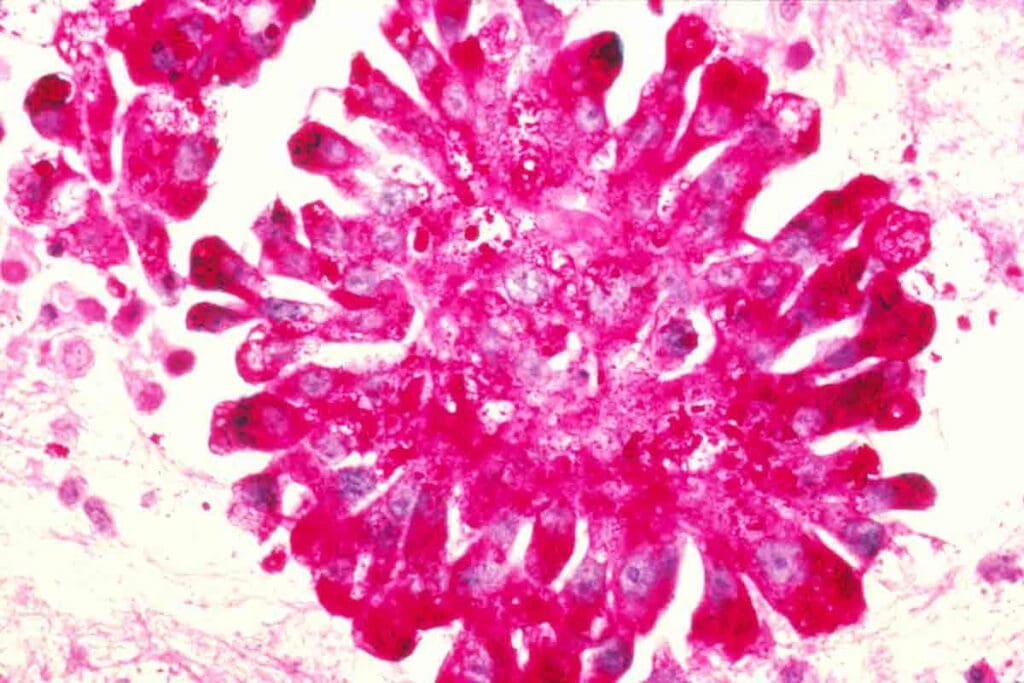Last Updated on November 20, 2025 by Ugurkan Demir

Many think all unusual lumps or growths in muscles and soft tissues are cancerous. But, it’s not that simple. Sarcomas, rare cancers, can come from different tissues like muscle, fat, and bone. They can be harmless or very aggressive. Discover if all sarcomas are malignant and how cancer muscle tissue tumors differ from benign growths.
At Liv Hospital, we know how important it is to understand sarcomas. We see that not all sarcomas are bad. There are benign and in-between types, each with its own care needs.

Sarcomas are a complex group of cancers. They start in the body’s soft tissues and bones. We will look into their definition, origin, and how common they are. This will help us understand their impact on different people.
Sarcomas come from the body’s connective tissues. This includes muscles, fat, tendons, and blood vessels. They can appear anywhere in the body. They start from mesenchymal cells, which are the basic cells of connective tissue.
The exact cause of sarcomas is not known. But, genetic changes and environmental factors are thought to contribute. For example, radiation and some chemicals can increase the risk of getting sarcomas.
Sarcomas are rare, making up less than 1% of all new cancer cases. The American Cancer Society says over 13,000 new soft tissue sarcoma cases are diagnosed in the U.S. each year.
The people who get sarcoma vary. Some types are more common in certain age groups. For example, rhabdomyosarcoma often affects kids, while leiomyosarcoma is more common in adults.
| Type of Sarcoma | Typical Age Group | Common Locations |
| Rhabdomyosarcoma | Children and adolescents | Head and neck, urinary tract |
| Leiomyosarcoma | Adults (40-60 years) | Uterus, abdomen, blood vessels |
| Liposarcoma | Adults (50-70 years) | Thighs, abdomen |
Knowing about sarcomas’ origin, development, and who they affect is key. We’ve seen they can start in different tissues and affect various age groups. This shows why awareness and full care are important.

Sarcomas come in different types, including benign, intermediate, and malignant. These tumors start in connective tissue, like fat, muscle, and blood vessels. Their growth can range from slow and non-cancerous to fast and cancerous, spreading to other parts of the body.
Benign soft tissue tumors are not cancerous and don’t spread. They are usually not life-threatening but can cause discomfort. Examples include lipomas and leiomyomas. Studies show benign tumors are more common than malignant ones, found on PubMed Central.
These tumors are often treated by removing them surgically. This usually solves the problem. But it’s important to watch them for any signs they might turn into a malignant tumor, though this is rare.
Intermediate tumors are between benign and malignant sarcomas. They can grow and damage nearby tissues but rarely spread. A good example is the desmoid tumor, also known as aggressive fibromatosis. These tumors are hard to treat because they can come back after surgery.
“The management of intermediate tumors requires a nuanced approach, balancing the need to control the tumor with the risk of aggressive treatments,” as clinical guidelines suggest.
Malignant sarcomas are cancerous and can spread. They grow fast and can invade nearby tissues and spread to other parts, mainly through the blood. Common types include leiomyosarcoma, liposarcoma, and synovial sarcoma. These tumors are aggressive and need quick treatment, often involving surgery, radiation, and chemotherapy.
Diagnosing and treating malignant sarcomas is complex. Experts say, “The best care for sarcomas needs a team effort from surgeons, medical oncologists, radiation oncologists, and pathologists to get the best results for patients.”
Bone sarcomas, like osteosarcoma and Ewing sarcoma, are tough to diagnose and treat. They start in the bone and can be very different in how they look and act.
Osteosarcoma is the most common bone sarcoma. It usually happens in long bones like the femur and tibia. Symptoms include pain and swelling in the affected limb.
To diagnose it, doctors use imaging studies and biopsies. We treat osteosarcoma with surgery and chemotherapy. Surgery aims to remove the tumor and keep the limb working. Chemotherapy fights any cancer cells that might have spread.
Ewing sarcoma is a very aggressive bone tumor. It can happen in any bone but often affects the pelvis and long bones. Patients may have fever, weight loss, and pain and swelling.
Treatment for Ewing sarcoma is a team effort. It includes chemotherapy, surgery, and radiation. The treatment plan depends on the tumor’s location and size.
Chondrosarcoma starts in cartilage cells and is common in older adults. It can be found in many bones. Chondrosarcoma is hard to treat with chemotherapy, so surgery is usually the main treatment.
Other bone sarcomas, like fibrosarcoma and undifferentiated pleomorphic sarcoma, also have their own challenges. We customize treatment based on the sarcoma type, its grade, stage, and the patient’s health.
Soft tissue sarcomas are a group of cancers that affect soft tissues in the body. These include muscles, fat, tendons, and connective tissues. They can happen anywhere and are named based on the tissue they start in.
Leiomyosarcoma is a rare and aggressive cancer that starts in smooth muscle cells. It can be found in many parts of the body, but often in the uterus, abdomen, and blood vessels. It grows quickly and can spread to other parts of the body, so early treatment is key.
Rhabdomyosarcoma starts in skeletal muscle cells. It’s the most common soft tissue sarcoma in kids and teens but can also affect adults. It can happen in any muscle group, but often in the head, neck, and limbs.
Liposarcoma starts in fat cells. It can appear anywhere with fat, but mostly in the abdomen, thighs, and knees. It can be low-grade or high-grade, with high-grade being more aggressive and likely to spread.
Synovial sarcoma is rare and usually found near joints in the arm, neck, or leg. It has unique genetic traits and can affect both kids and adults. Other types include undifferentiated pleomorphic sarcoma, myxofibrosarcoma, and angiosarcoma, each with its own features and behavior.
Knowing the different types of soft tissue sarcomas is important for correct diagnosis and treatment. Each type has its own traits, and treatment plans vary.
Knowing where a sarcoma is located is key to finding the best treatment. Sarcomas can happen in different parts of the body. This includes the skin, limbs, trunk, and deep areas like the retroperitoneum.
Skin sarcomas are rare but serious. They start in the skin. Dermatofibrosarcoma protuberans (DFSP) is a type that grows back if not removed fully.
Angiosarcoma is very aggressive and often shows up in areas that have been exposed to radiation. It’s important to catch and treat these quickly to stop them from getting worse.
Sarcomas in the arms and shoulders are tricky. They’re close to important parts and need to be treated carefully to keep the limb working.
These sarcomas usually need surgery, radiation, and sometimes chemo to get the best results.
Sarcomas in the trunk and retroperitoneum can grow big before they’re found. This is because these areas are quite large.
Retroperitoneal sarcomas are hard to remove because they’re near vital blood vessels and organs.
It’s vital to have a team of experts working together. This team should include surgeons, radiation therapists, and medical oncologists.
Soft tissue tumors can be benign. It’s important to know the difference between these and malignant tumors. This knowledge helps with diagnosis and treatment.
Benign soft tissue tumors include various growths in fat, muscle, and connective tissue. Lipomas are fatty tumors that feel soft and can appear almost anywhere. Fibromas are made of fibrous or connective tissue, often in the skin or organs. Myxomas are rare, benign tumors with a mucous-like texture, found in the heart, skin, or other organs.
These tumors are usually not dangerous and can be treated with observation or minor surgery. It’s key to know the characteristics of these benign tumors to tell them apart from malignant sarcomas.
Telling benign from malignant soft tissue tumors is vital for treatment. Benign tumors grow slowly and don’t spread. Malignant tumors grow fast, invade nearby tissues, and can spread.
Imaging studies (like MRI, CT scans) and biopsy are key for diagnosing these tumors. They help figure out if they are benign or malignant.
Knowing the differences between benign and malignant soft tissue tumors helps patients and doctors make better treatment choices.
Diagnosing sarcomas is a detailed process. It involves clinical checks, imaging, and biopsy results. We’ll walk you through diagnosing sarcomas, from first signs to biopsy confirmation.
Sarcoma symptoms vary based on the tumor’s location and type. You might notice a lump, pain, or trouble moving if it’s near a joint. For example, soft tissue sarcomas often start as a painless lump that grows.
Imaging is key in diagnosing sarcomas. We use different methods to see the tumor’s details. These include:
A biopsy is essential for sarcoma diagnosis. It takes a tissue sample from the tumor. The type of biopsy depends on the tumor’s location and size. Pathology examines the sample to confirm cancer and its type.
| Diagnostic Step | Purpose | Methods |
| Initial Evaluation | Identify symptoms and signs | Clinical examination, patient history |
| Imaging | Assess tumor characteristics and extent | X-rays, CT, MRI, PET scans |
| Biopsy | Confirm diagnosis | Needle biopsy, surgical biopsy |
| Pathological Examination | Determine the type and grade of sarcoma | Microscopic examination of the biopsy sample |
By using these steps, we can accurately diagnose sarcomas and plan treatment.
Treating sarcomas is complex and depends on several factors. These include the type, stage, and location of the tumor, and the patient’s health. A team of experts works together to find the best treatment plan.
Surgery is often the first step in treating many sarcomas. It’s used for tumors that can be removed without harming the body too much. The goal is to remove the tumor and some healthy tissue around it to get rid of all cancer cells.
In some cases, surgery might be followed by other treatments like radiation or chemotherapy. This helps make the treatment more effective.
Radiation therapy uses high-energy waves to kill cancer cells. It’s often used with surgery to treat sarcomas. It can be used before surgery to shrink the tumor or after to kill any remaining cells.
The choice to use radiation therapy depends on the sarcoma’s type, stage, and the patient’s health.
Chemotherapy uses drugs to kill cancer cells. It’s used for sarcomas that have spread or are at high risk of coming back. Chemotherapy plans vary based on the sarcoma type, stage, and the patient’s health.
Chemotherapy might be given before surgery to make the tumor easier to remove. Or, it might be used after surgery to kill any cancer cells left behind.
Targeted therapies and immunotherapy are newer ways to treat sarcomas. Targeted therapies use drugs that target cancer cells, harming normal cells less. Immunotherapy boosts the body’s immune system to fight cancer cells better.
These treatments are used for advanced sarcomas or when other treatments haven’t worked. They offer hope for patients with certain types of sarcomas.
Living with sarcoma means knowing a lot about the disease. It affects how you live every day. The disease’s outlook depends on the tumor’s type, stage, and where it is. It also depends on your overall health.
Survival rates for sarcoma patients depend on several things. These include the cancer’s type and stage at diagnosis. Early-stage sarcomas usually have a better outlook than those found later.
| Type of Sarcoma | 5-Year Survival Rate (Localized) | 5-Year Survival Rate (Regional) | 5-Year Survival Rate (Distant) |
| Soft Tissue Sarcoma | 65% | 50% | 15% |
| Osteosarcoma | 70% | 60% | 30% |
| Ewing Sarcoma | 75% | 65% | 35% |
These survival rates are based on data from patients with sarcomas. They show how important early detection and treatment are. Remember, these rates are averages and don’t predict what will happen to you.
Long-term monitoring and follow-up care are key in managing sarcoma. Regular check-ups and imaging studies help catch any signs of the cancer coming back early. This makes treatment more effective.
Key aspects of follow-up care include:
Good follow-up care helps healthcare providers catch and treat problems quickly. This improves your quality of life.
Understanding your prognosis and following a care plan helps sarcoma patients. It lets them make informed choices about their treatment.
Getting a correct diagnosis and specialized care is key for better outcomes and quality of life for sarcoma patients. We’ve talked about the different types of sarcomas and why it’s important to tell them apart.
A team effort is needed for treatment. This includes surgeons, oncologists, radiologists, and more. Early detection is also key, showing how important it is to act quickly.
Supporting sarcoma patients fully is also critical. This includes emotional, psychological, and social support. By focusing on accurate diagnosis, specialized care, and support, we can make a big difference in their lives.
A sarcoma is a type of cancer. It grows in the soft tissues or bones. This includes muscle, fat, and connective tissue.
No, not all sarcomas are malignant. Some are benign, some are intermediate, and some are malignant. Each has its own characteristics and implications.
A benign sarcoma is non-cancerous and doesn’t spread. A malignant sarcoma is cancerous and can spread to other parts of the body.
Bone sarcomas include osteosarcoma, Ewing sarcoma, and chondrosarcoma. Each has its own characteristics and treatment options.
Soft tissue sarcoma is a cancer in the soft tissues. This includes muscle, fat, and connective tissue. It has subtypes like leiomyosarcoma and liposarcoma.
Yes, sarcoma can happen in the skin. Types include dermatofibrosarcoma and angiosarcoma. They need a specific diagnosis and treatment.
Sarcomas are diagnosed with imaging like X-rays, CT scans, and MRI scans. Then, a biopsy and pathological exam confirm the diagnosis.
Treatments include surgery, radiation, chemotherapy, targeted therapies, and immunotherapy. The choice depends on the type and stage of the disease.
The prognosis varies by type and stage of sarcoma. Early detection and treatment improve survival rates.
Generally, no. But it’s important to watch them and see a doctor if they change.
Long-term monitoring is key. It helps catch recurrence or metastasis early. This allows for timely treatment and better outcomes.
Yes, sarcomas are rare. They make up a small percentage of all cancers. They can happen in different ages and groups.
Yes, sarcoma can happen in the forearm or shoulder. It needs specific diagnosis and treatment because of its location and the tissues around it.
A team of surgeons, oncologists, radiologists, and others is vital. They provide complete care for sarcoma patients.
Subscribe to our e-newsletter to stay informed about the latest innovations in the world of health and exclusive offers!